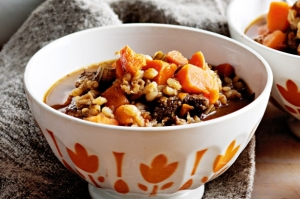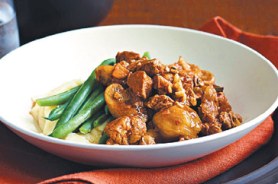 Beef and Veal
Beef and Veal
Alright! It’s time to talk about one of my favourite dinner and lunch options! Beef! This tasty morsel is one I have been brought up on since I can remember and I can never get enough of it. Of course it is not the only kind of meat out there to be had but beef is by far the most versatile meat product on the market – tell me I’m wrong and I’ll eat my own words and the dishes that beat out beef.
What is it?
Beef is a popular cut of red meat acquired from the flesh of cows. It comes in a variety of shapes, sizes and cuts, each with its own appropriate use. It is sold raw to the public, allowing for those who purchase it to cook it the way they wish. It’s appearance varies from cut to cut, but all uncooked pieces of beef are red in colour and are soft in texture. Once cooked however their appearance changes and the its red flesh will begin to turn either brown or a grey-brown colour, the inside of the beef will still remain red unless cooked all the way through – if this is your preference. Beef can be cooked a myriad of different ways; you can grill it, bake it, stew it, fry it, and roast it. Beef also can be used in a number of ways, you can cook it plain, use it in a sandwich, put it in pasta, turn them into rissoles, and bake them in pies, just to name a few ways.
What benefits do we get from eating it?
There is no question that beef is a highly nutritious source of food with its main claim to fame being its fantastic source of high-quality protein. Protein is one of the most abundant molecules found in the body and is a nutrient needed for body growth and maintenance. It is found in all the cells of the body and is considered a major structural component, especially in muscle. Proteins are utilised in a number of areas in the body, when broken down into amino acids they are used as precursors to nucleic acid, biological molecules essential for encoding, transmitting and expressing genetic info and vitamins. They also contribute to the formation of hormones and enzymes that help regulate metabolism, and support the immune system. Also protein plays an integral role in the building of new muscle tissue as well the repair of damaged muscle tissue; which is why you see all those muscle daddies drinking those grey coloured milk shakes; their packed full of protein….
Not only is beef abundant in protein but it also provides a substantial per cent of the RDI of vitamin B12, an essential nutrient that plays a key role in a number of bodily functions. Vitamin B12 helps maintain a normal functioning of the brain and nervous system and the formation of blood. It is involved in the metabolism of the body’s cells, especially affecting DNA synthesis and regulation, as well the synthesis of fatty acids and energy production.
Beef is also an excellent source of Vitamin B6, niacin, riboflavin, as well as two essential minerals needed for a healthy diet, zinc and iron. Iron is a trace mineral that is needed to prevent anaemia and aid in the health of red blood cells, and thedistribution of oxygen (as part of the protein haemoglobin). It also helps to create neurotransmitters in the brain and plays a role in aiding the immune system. Zinc is another trace mineral that helps aid muscle production, the healing of cuts and abrasions, and reproduction.
What negative are there from eating beef?
While there are number of reasons egging us on to consume beef, there are a few drawbacks that come if we possibly eat too much of the meat. The main one is that fact that there is a considerable amount of saturated fats found within a number of different cuts. Not only that but studies have shown that a diet high in meat can lead to an increased risk of heart attack and colorectal cancers. Some studies have argued that the use of hormones in beef can play a role in impeding or messing with the normal functions of the body and its development; however most scientists argue that the added hormone levels found in most animals were insufficient in playing any adverse role in our health.
The only other negative aspect from eating beef that really can be seen is the contraction BSE (bovine spongiform encephalopathy), or ‘mad cow disease’. A fatal disease of the nervous system found in cows, and transferred to humans through the consumption of infected animal materials such as beef patties. However it is rare for this kind infection to spread as the contagion is generally found early and is not put on the slab. Of course you do have occasional Mad Cow Macca’s Burger…
What kinds of cuts are there?
So we all know that beef is yummy and very healthy for you, as long as you eat it sensibly, but with so many types of cuts out there it’s sometimes hard to discern which cut is the best one for you. I have pain-steak-ingly looked at a number of options for you all and will give you a description of a number of choice cuts and what they are best suited for.
T-bone
The T-bone cut gets its name from the T shaped bone that is found on the side of the beef. It is a popular item purchase as this steak offers the consumer a double selection in choice of meat. The flesh of a T-bone consists of two different parts, the lager side having a porterhouse type of beef and the smaller side possessing an eye fillet type of beef. This type of beef is best dry heat cooked on a barbeque or grill and served with a side dish of some sort, be it mash potato and steamed vegies, or chips and a salad. It’s versatile in its use as it can be marinated and salted to your liking. I like adding some ground up garlic and chilli to mine and then finishing it off with a bit of sage butter and a salad.
Porterhouse
The Porterhouse beef is a popular, but sometimes expensive, cut of beef found in delis, meat departments and most restaurants. It is a thicker cut slab of beef taken from the short loin of the beef. It is generally found on a T-bone cut but can also be distributed separately. The tenderness of the porterhouse is pretty standard and is considered to be less tender than that of its neighbour the eye fillet. Most people who cook this steak prefer a slow cooking method and will also tend to grill this beef leaving the thick inner meat soft and juicy while the outside a little more rough. Because of the thickness it can sometimes take a while longer to marinate and cook but if done correctly more than makes up for when you have the finished product.
Eye Fillet
The eye fillet cut of beef is the most tender part because this muscle does the least amount of work. An eye fillet can also be referred to as tenderloin because of its soft feel. This type of beef cooks best when roasted but will also cook well on the barbeque and takes well to salt and spiced rubs. Because of its quality the eye fillet is considered to be a pricey piece of meat. But when shopping smart you can sometimes find a reasonably priced slab of eye fillet.
Mince
This one is pretty easy to deduce, minced beef also known as ground beef. Generally speaking when you purchase mince you are buying a very multi-talented piece of beef. As you all know mince is shredded beef, but what kind of beef you wonder? I can assure you that unless it is high quality mince it will more than likely be the last and least edible cuts from beef that were unable to be used as steaks. This is no way means that it should not be eaten, it just means that in a minced form this beef is a lot easier to eat. And to be honest I’ve never had any complaints from using mince – hell I love it!
Veal
Veal, depending on where you hail from nationally, can mean a number of different meats. It is a controversial cut of beef that some people try and avoid because of the nature in which it is derived. Here in Australia it refers to cuts of meat (not only beef) that are taken from younger animals – in this instance calves. However the reason they are produced is because they are believed to be more tender and they do not take as long to raise and procure.
Heart Smart
This is what is recommended for consumption if you are trying to eat healthy. Heart smart beef is low in salt and is pan ready for easy cooking. You would think that with it being lower in salt the price would be a sacrifice in flavour. You’d be slightly correct, but the thing is if you know how to work around the system and use spices and healthy natural marinades you can overlook this little set back.
So with all these tid-bits of info have I made it a little easier for you discern why beef is good for you and what kind should be used when you want to fry or roast? I thought this blog was a really fun one to research and I had an interesting time trying a recipe or two to give you this week. Have a go at some of them and then tell me what you think. =D
Read more…








